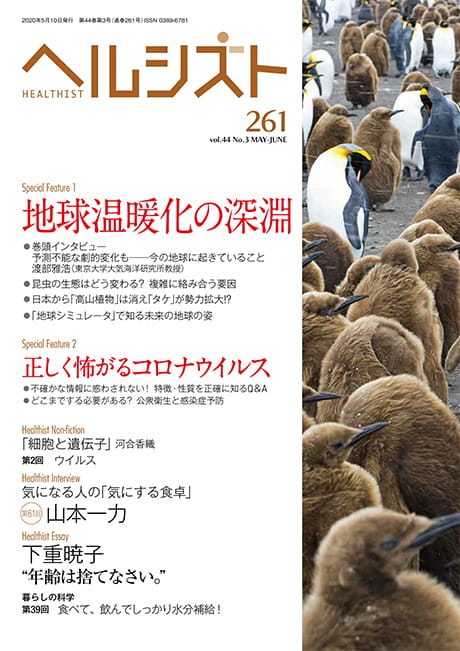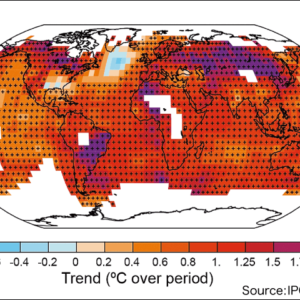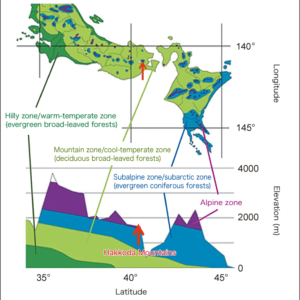Climate change affects insect populations in various ways, such as north- or southward range expansion, changes in the number of annual generations, and asynchrony between the emergence season of insects and host plant phenology. We often try to simply attribute drastic changes in insect population density to global warming. However, causality does not seem to be that simple. Long-term field surveys are essential to explain causal relation between drastic changes and global warming. How will be insect life affected by global warming?
Special Feature 1 – The Abyss of Global Warming How will be insect life affected by global warming? Intricately intertwined factors
composition by Rie Iizuka
We sometimes say that the number of insects has decreased or increased because of global warming. Let us reconfirm what the “number of insects” refers to.
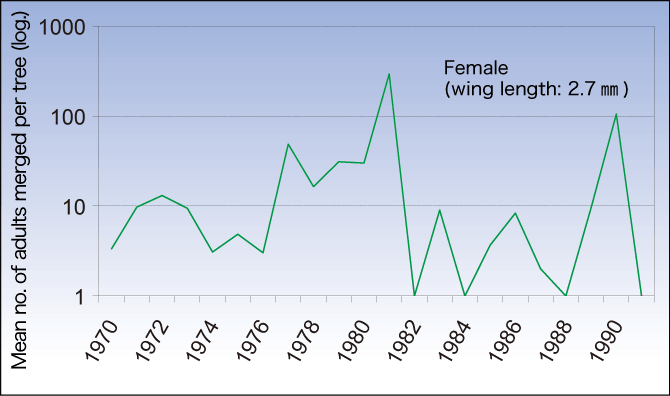
Figure 1. Annual changes in the number of adults of Asphondylia sphaera (Diptera: Cecidomyiidae) that emerged from fruit galls on Ligustrum japonicum (Oleaceae).Population dynamics of A. sphaera was studied for 20 years from 1970 to 1990. Population density of the insect fluctuates more tremendously than we imagined.
The number of insects is known to fluctuate greatly from year to year (Figure 1). In some insect populations, the range of fluctuation between minimum and maximum numbers sometimes exceeds 3,000 times. For example, in an insect population consisting of 50 males and 50 females (sex ratio = 1:1), if one female lays 100 eggs and two of them can survive to the adult stage (one male and one female), the emerged female can mate and lay 100 eggs. Thus, the original number in the population can be theoretically maintained as long as the survival rate remains to be 2%. If the survival rate merely increases to 4%, the number of individuals in the following generation will be 200. If high survival rates continue for several generations, the number will tremendously increase. In the case of insects that lay hundreds of eggs, the fluctuation in the number becomes extremely large.
Biotic factors and abiotic factors
Factors that affect the survival rate of insects from the egg to adult stage can be categorized into biotic and abiotic factors. The former includes the amount of food resources (host plants in case of herbivorous insects), parasitoids, and predators, and the latter includes temperature, humidity, sunlight, and strong wind. These factors affect the survival of insects directly or indirectly through other factors. Global warming is an abiotic factor that fundamentally affects insect populations directly. The effects of global warming increase the survival rate in some cases while decreasing it in other cases, depending on the developmental stage of insects. Therefore, the relationship between the number of insects and global warming should essentially be analyzed not solely based on changes in the population size of one insect species, but also based on changes in the intensity of various biotic factors relating to that species. At least, not much could be learned from one or two years of observation data.
On the basis of having understood the premise concerning the number, it is understandable that global warming affects insect populations in various ways, such as changes in the distribution range, an increase in the number of annual generations, asynchrony between insect and host plant phenology, high temperature stress, and a decline in diversity.
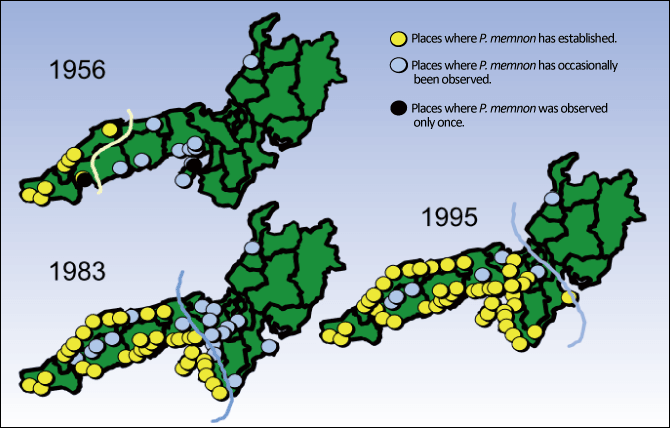
Figure 2. Northward range expansion of Papilio memnon (Lepidoptera: Papilionidae)Papilio memnon has steadily expanded its range northward due to global warming. It arrived in Kanagawa Prefecture in 2003.
Papilio memnon exhibits a typical example of northward range expansion (Figure 2). Dr. Masanobu Yoshio (Tokyo College of Environment) and Dr. Minoru Ishii (formerly Osaka Prefecture University) considered that the northward range expansion of P. memnon was not caused by intraspecific diversification related to diapause or cold hardiness, but by global warming. Later, Dr. Masahiko Kitahara (Yamanashi Institute of Environmental Sciences) and his colleagues studied changes in the annual mean temperature at places where P. memnon was newly observed. They clarified that P. memnon established itself at places where the annual mean temperature exceeds 15℃, and thus confirmed the effect of global warming.
There is another example of northward range expansion of an invasive stinkbug due to global warming. The southern green stink bug Nezara viridula (Hemiptera: Pentatomidae) expanded its range northward and reduced the distribution range and population size of a native congeneric species.
Tropical stinkbug living in Japan
Nezara antennata was distributed widely in Japan. However, in the 1950s, N. viridula came to Japan from tropical or subtropical regions and established itself in southern parts of Kyushu, Shikoku, and the Kii Peninsula. Subsequently, N. viridula started to expand its range widely to southwestern parts of Japan because in these areas the mean monthly temperature in the coldest month began to exceed 5℃ due to global warming, which is sufficiently high for N. viridula to overwinter.
Up to present, N. viridula has reached Ibaraki Prefecture on the Pacific side and Shimane Prefecture on the Sea of Japan side. Because N. viridula is a pest that sucks sap from rice plants and field crops, its food resources are available wherever it expands the distribution range. In addition, around that time, the paddy rice cropping system was changed, and rice plants began to be cultivated over a long period from early to late rice-growing seasons. This was a favorable factor for N. viridula that prefers rice plants to other field crops and has three generations per year. In this way, the relative abundance of N. viridula to N. antennata distinctly increased.
Another factor that promoted this trend was interspecific mating between the two Nezara species, although such mating is uncommon for ordinary insects. In the interspecific mating, eggs are not fertilized and do not hatch. This is also true for both Nezara species. However, N. viridula has at least three generations per year, whereas N. antennata is bivoltine. Therefore, the population density of N. viridula became overwhelmingly higher, and led to a loss of opportunities for intraspecific mating of N. antennata. As a result, N. antennata became locally extinct, and Kyushu, Shikoku, and the southern Kii Peninsula became habitats of N. viridula alone.
The effect of global warming is not limited to the decrease of overwintering mortality by rising winter temperature. A study of a cicada, Cryptotympana facialis (Hemiptera: Cicadidae), by Dr. Hideharu Numata (Kyoto University) and his colleagues showed that high temperature during the egg stage shortened the developmental period of eggs and increased the population size. Eggs of C. facialis used to hatch after the early-summer rainy season (Baiu). Due to global warming, however, the eggs have come to hatch before the end of the rainy season, which enabled young larvae to easily get into the ground softened with rain. As a result, the survival rate of hatched larvae became higher, leading to an increase of the population size.
Of course, global warming also negatively affects insects.
In many herbivorous insects, newly hatched larvae feed on soft parts of their host plants, such as extending shoots, flower buds, and fresh leaves, because they cannot eat hard plant organs with their underdeveloped mouthparts. Therefore, the timing of hatching needs to synchronize with the season when host organs are suitable for feeding.

Figure 3. Synchrony between insect emergence and leaf-opening (Conventional pattern and pattern under global-warming conditions)The emergence curve used to have a sufficient width to be able to synchronize with host plant phenology, but the curve has come to shift to have no overlap with the phenology due to global warming.
Phytophagous insects are greatly affected by the synchrony with the host phenology (the timing of seasonal biological phenomena) (Figure 3). Thus, they have evolved to be able to synchronize their emergence season with the host plant phenology, such as the flowering or leaf-opening seasons. Even so, the timing of adult emergence of insects and the plant phenology vary from year to year.
Nevertheless, the timing of the adult emergence spans over a certain period, so even if the synchrony is not completely overlapped, some adults of the population can synchronize with the host plant phenology and they can contribute to the next generation. However, there is a growing fear that the extent of such asynchrony due to global warming will become too large for insects to adapt.
Concerns about local extinction
The neolitsea leaf gall midge, Pseudasphondylia neolitseae (Diptera: Cecidomyiidae), lays eggs into a newly extending shoot of Neolitsea sericea (Lauraceae) that is 22 to 38 mm in length and dies on that day. As the shoots of N. sericea extend at a later timing around the crown of the tree and earlier on lower branches, the gall midge females search for shoots with lengths suitable for oviposition, but there are limits. If the asynchrony with the host plant phenology becomes too large, the gall midge cannot lay eggs. Particularly in warm regions, there is a risk that the timing of adult emergence of the gall midge could come quite early due to global warming, and there would be no shoots with an appropriate length even on lower branches. If so, the gall midge would be unable to lay eggs, and may become locally extinct. For species like gall midges, which have short adult life spans, asynchrony with their host plants is fatal.
The effect of global warming also increases the number of annual generations. Dr. Keiji Kiritani (formerly the National Institute for Agro-Environmental Sciences) estimated the increase in the number of annual generations of insects and spiders living in paddy fields in the case when the annual mean temperature increased by 2℃ from 15℃ due to global warming. His estimation was based on data of the lower developmental threshold temperature (the temperature below which the development stops) and thermal constant (the total amount of temperature above the lower developmental threshold temperature required for the development from the egg to adult stage) of the insects and spiders. The study showed that the number of generations was not expected to increase for spiders, but the number was expected to increase for parasitic wasps that attack eggs of pests in paddy fields.
While we have assumed that global warming would change the distribution ranges of insects, it also causes a critical effect called heat stress.
Dr. Kenji Fujisaki (formerly Kyoto University) reared N. viridula from the egg to adult stage from June to August in a cage under outside temperature (control group) and in an incubator at a temperature 2℃ higher than outside (experimental group), and compared their development.
Insects are known to develop faster, but with smaller body sizes, under high temperature conditions. In June, the developmental period was shorter for the experimental group, but no difference was observed in size between the two groups. In July, the experimental group similarly showed fast development, and the body size was slightly smaller than that of the control group.
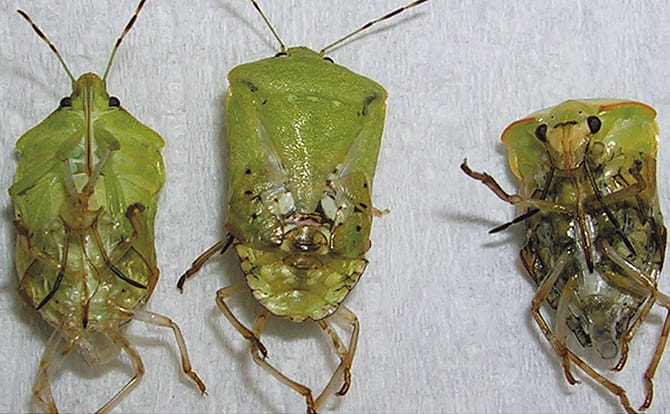
Figure 4.
Examples of abnormal emergence of Nezara viridula because of heat stress (Photograph courtesy of Kenji Fujisaki)
However, a strange thing happened in August. The control group showed faster development and a smaller body size, which was within expectation. In the experimental group, many individuals showed a substantial delay in development, inability to molt to adults, notably small body size, and failure in morphogenesis. Dr. Yoshitomo Kikuchi (National Institute of Advanced Industrial Science and Technology) and his colleagues found that high temperatures in the midsummer season negatively affect N. viridula indirectly via the heat-vulnerable obligate bacteria symbiont. The study indicated that the occurrence of N. viridula was inhibited under abnormally high midsummer temperature conditions caused by global warming (Figure 4).
Many insects that enter summer diapause must have acquired an adaptation strategy to avoid heat stress. Nezara viridula, of tropical origin, might suffer heat stress because it has not acquired such an adaptive strategy as summer diapause.
Population fluctuation is determined by various intertwined factors
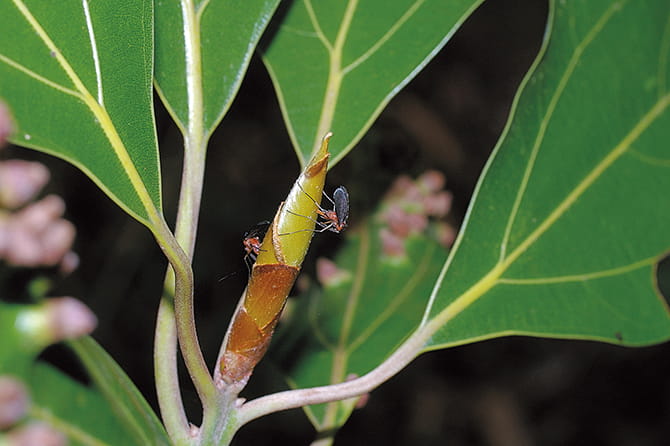
Figure 5.
A female of Pseudasphondylia neolitseae laying eggs into a shoot of Neolitsea sericea. Later, many galls appear on the fresh leaves of N. sericea.
We are apprehensive that insects will become extinct as global warming progresses. Indeed, if P. neolitseae become extinct, associated parasitic wasps will also be affected. Insects inhabiting galls of P. neolitseae will lose their habitat. If one insect species becomes extinct, the community centered upon that species would be certainly affected (Figure 5).
However, we cannot easily conclude to what extent and how global warming affects insects based solely on one phenomenon. This is because population fluctuation of insects is determined by various intertwined factors. In addition, if the environment changes, insects also begin to adapt to that change. Extant species may have become locally extinct, whilst some other changes will occur to maintain the balance. Ecological traits of insects have been certainly changing by the progress of global warming, but to evaluate its impact, we need to take complex factors into consideration based on long-term field surveys.







